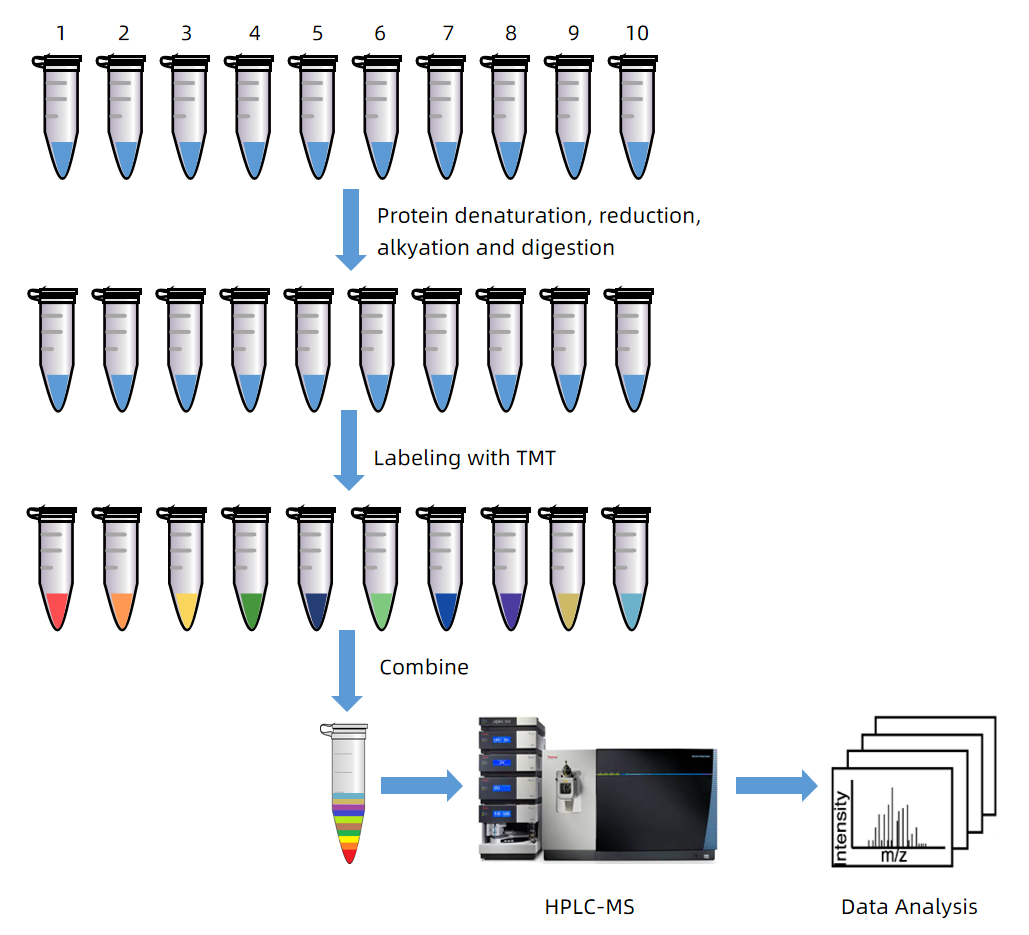TMT Quantitative Proteomics Analysis Service
Tandem mass tags (TMT) technology is a tandem mass spectrometry labeling technology developed by Thermo Fisher Company, mainly used for the identification and quantification of proteins in different samples. Each TMT labeling reagent consists of an NHS-ester group with amine-reactive activity, a mass normalization group, and an MS/MS reporter group. The isotope label of each labeling reagent has the same precursor mass. After the peptide segments are labeled by the reagent, they can react with the N-terminal and primary amine groups of the amino acid side chains and then be detected through the reporter group.
TMT technology can use up to 18 stable isotope tags, enabling the simultaneous comparison of protein levels across 18 different samples. This technique can label virtually all peptide or protein samples, making it a widely adopted method for discovering quantitative protein biomarkers. Depending on the experimental requirements, 2-plex, 6-plex, 10-plex, 11-plex, 16-plex or 18-plex isotopic tags can be employed to compare the relative protein abundance across 2, 6, 10, 11, 16 or 18 sample groups, respectively.
TMT quantitative analysis is performed by measuring the intensity of the fragment reporter group ions released in tandem mass spectrometry mode (MS2) during peptide fragmentation. Precursor ions are selected for fragmentation in full scan mode (MS1), and the ion selection step reduces noise levels, providing favorable conditions for subsequent analysis steps. Ideally, only one selected precursor ion undergoes fragmentation during the precursor ion fragmentation process. However, in practice, other precursor ions are usually captured within the specified m/z window and fragmented together with the selected precursor.
MtoZ Biolabs uses Thermo Fisher's Orbitrap Fusion Lumos mass spectrometry platform combined with nano-liquid chromatography to provide TMT Quantitative Proteomics Analysis Service. The Orbitrap Fusion Lumos mass spectrometer is the highest resolution and sensitivity mass spectrometer currently available, ensuring the sensitivity for identifying low-abundance peptide fragments. Additionally, it employs a combination of HCD and ETD modes during peptide fragmentation, ensuring the integrity of peptide fragments.
Analysis Workflow
The general process of TMT is illustrated below. Different protein samples are denatured, reduced, alkylated, and digested into peptides. These peptides are then labeled with a TMT kit and merged into a single sample. The merged sample is separated into fractions using high-performance liquid chromatography (HPLC), and the fractions are then grouped into 10 samples. After purification, each sample is analyzed by HPLC-MS to gain protein qualitative and quantitative data.

Figure 1. Workflow for Relative Quantification Using 10 plex TMT
Service Advantages
1. High Throughput with No Sample Number Limitations
A single run can quantify proteins in up to 18 samples simultaneously. For studies involving more than 18 samples, internal standards can be used to align data across multiple runs, thus enabling comprehensive comparisons without restrictions on sample numbers.
2. Enhanced Quantification Accuracy and Reproducibility
By labeling different samples and processing them together uniformly, the TMT method minimizes experimental variations typically introduced by separate handling and analysis, thereby improving both the accuracy and reproducibility of quantification.
3. Broad Protein Detection Capability
The TMT approach is applicable across all species, without any species-specific restrictions. It is effective in detecting a wide range of proteins, including cytoplasmic, membrane, nuclear, extracellular, and secreted proteins. The technique accommodates a broad spectrum of protein abundances and molecular weights, facilitating the detection of low-abundance proteins, highly alkaline proteins, and proteins smaller than 10 kDa or larger than 200 kDa.
Sample Submission Requirements

MtoZ Biolabs can perform TMT proteomics analysis on samples in both liquid and solid states. Solid samples can be transported with ice packs; liquid samples can be vacuum-dried or freeze-dried and transported with ice packs or transported with dry ice. Welcome to call for consultation.
MtoZ Biolabs, an integrated chromatography and mass spectrometry (MS) services provider.
Related Services
Label-Based Protein Quantitative Service—iTRAQ, TMT, SILAC
How to order?







